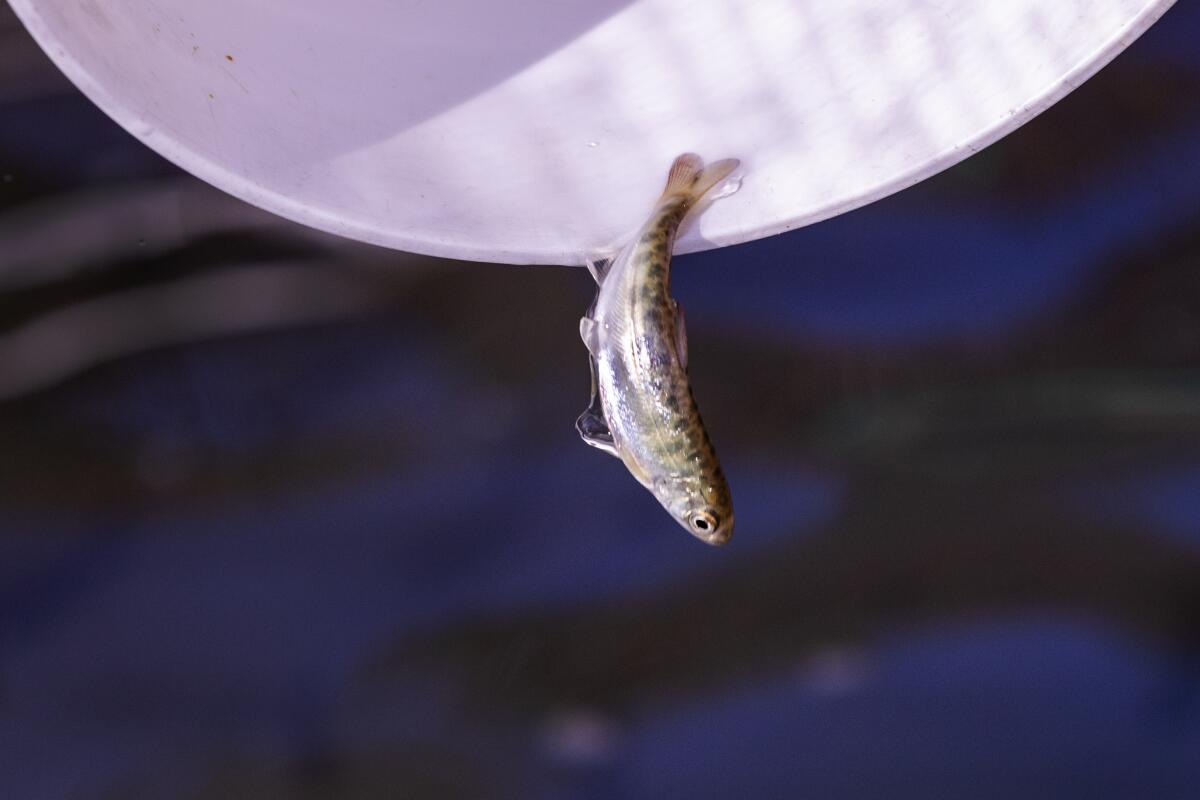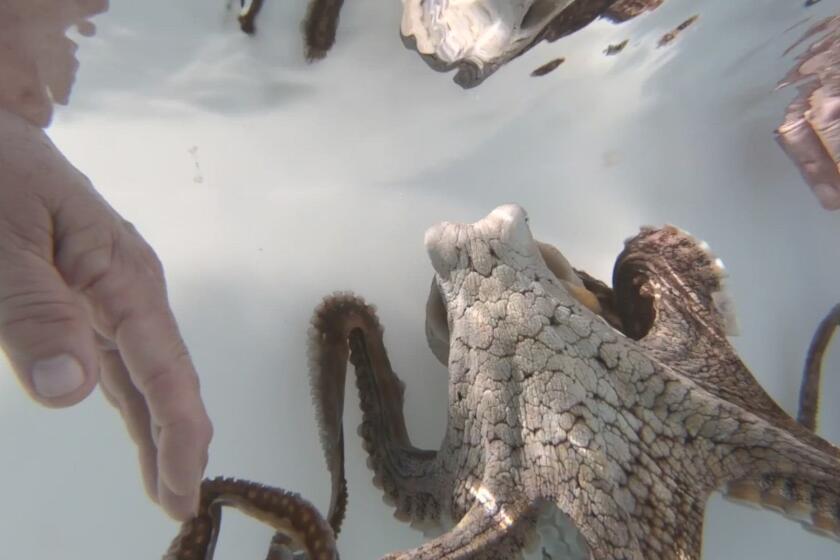California’s endangered salmon population plummets amid new threat

- Share via
They’ve been pushed to the brink of extinction by dams, drought, extreme heat and even the flare of wildfires, but now California’s endangered winter-run Chinook salmon appear to be facing an entirely new threat — their own ravenous hunger for anchovies.
After the worst spawning season ever in 2022, scientists now suspect the species’ precipitous decline is being driven by its ocean diet.
Researchers hypothesize that the salmon are feasting too heavily on anchovies, a fish that is now swarming the California coast in record numbers. Unfortunately for the salmon, anchovies carry an enzyme called thiaminase, which breaks down thiamine — a vitamin that is essential to cell function in all living things.
“These are fish that returned to the river early [last] year and then spawned in the spring and early summer. They had really low thiamine,” said Nate Mantua, a fisheries researcher with the National Marine Fisheries Service in Santa Cruz. Concentrations were “worse than” the previous year.
In humans, a critical deficiency of thiamine, or vitamin B1, can lead to heart failure and nerve damage. In female salmon that are returning to rivers and streams to spawn, thiamine deficiency can be passed on to their many hatchlings, which suffer problems swimming and experience high rates of death, researchers say.
Now, with government agencies and Native American tribes fearing the collapse of the winter-run Chinook, scientists are embarking on a campaign to determine why the anchovy population has exploded off the California coast, and why winter-run Chinook are seemingly ignoring all other prey.
As dams and global warming push endangered California salmon to the brink, a rescue plan is taking shape — and a tribe pushes for recovering their sacred fish.
“The very unusual thing about their diet is that it’s been so focused on anchovies and so lacking in other things that historically they have been found eating,” Mantua said. “It is something we don’t have great information on.”
Researchers at the National Oceanic and Atmospheric Administration, California’s Department of Fish and Wildlife and UC Davis are employing new technologies, such as environmental DNA sampling and isotopic analyses of fish eye lenses, along with older methods — such as plankton sampling and fish ear bone studies — to better understand how and why the salmon ocean diet has changed.
Scientists first discovered salmon were suffering from a vitamin deficiency in 2020, after hatchery workers noticed salmon fry behaving strangely — swimming repeatedly in tight, corkscrew-like patterns before spiraling to their deaths at the bottom of the tanks. They learned a similar situation had occurred in the Great Lakes in the 1960s, when lake trout had exhibited similar behaviors after gorging on alewives, another fish chock-full of thiaminase.
State, federal and UC Davis researchers quickly treated the swirling salmon fry with thiamine — infusing the water in their tanks with the vitamin; the salmon soon recovered.
But over the last three years, thiamine concentrations in salmon eggs have continued to drop.
“We thought initially it was just a one-year thing, maybe the way we thought of COVID,” said Rachel Johnson, a fisheries biologist with the National Oceanic and Atmospheric Administration and UC Davis. “I was cautiously optimistic that the ocean was going to rearrange itself back to normal. And we just haven’t seen that.”
Chinook salmon start their lives in the rivers of Central and Northern California, before migrating downstream to the Pacific Ocean. There, they typically spend the next two to three years feeding on a variety of fish and invertebrates — such as squid — off the coast.
But ever since anchovy numbers began to balloon in 2016, they have triggered feeding frenzies among salmon and other predators. Humpback and gray whales have been seen in record numbers lunge feeding on the forage fish, and last summer San Francisco residents complained of fish falling from the sky — probably the result of birds dropping fish from their over-stuffed talons or beaks.
Mantua and Johnson are investigating whether there is a seasonal component to the winter-run Chinook’s taste for anchovies.
“Some of the diet data we have from the ‘50s and ‘70s and ‘80s show that salmon that were caught off of Central California would typically have herring, crab and krill in the winter, early-spring diets. Then juvenile rockfish would become a bigger component in the spring and early summer. And it wasn’t really until August and September that anchovies and sardines were the dominant prey item,” Mantua said.
Johnson’s lab is attempting to figure that out by examining the lenses of fish eyes.
Like an onion, the lenses accumulate layer upon layer over a salmon’s lifetime. Examining the chemical isotopes in each layer, Johnson and her colleagues can get an idea of what kinds of foods the salmon were eating and when.
“It’s kind of like a diet journal ... that allows us to check in over the lifetime of a salmon,” she said.
Salmon fry in California are suffering from an apparent vitamin deficiency that is threatening fish and other wildlife worldwide. But what is the cause?
Meanwhile, she and her colleagues at the hatcheries continue to treat fry with thiamine and inject the vitamin into egg-bearing females.
Winter-run Chinook are one of four distinct seasonal runs of salmon that populate the Sacramento River and its tributaries, but are the only one that has been declared endangered by the state and federal government. The name “winter-run” refers to the season in which sea-faring salmon return to San Francisco Bay to make their long journey to spawn in ancestral headwaters.
Those cool headwaters, however, have long since been blocked by dams, and the fish have been forced to lay their eggs in Central Valley waters in the heat of summer, causing many eggs to die. Today, the winter-run Chinook survive only through the intervention of government hatcheries and periodic releases of cold water from the same dams that block their passage upstream.
In the last several years, drought, extreme heat and debris flows from wildfire burn scars have taken a huge toll on their numbers, along with thiamine deficiency.
According to federal data, the total number of juvenile winter-run Chinook that were counted swimming downstream past the Red Bluff Diversion Dam in 2022 was 181,000 — the lowest on record. In 2021, the number was 558,000, and in 2020, it was just over 2 million.
Egg-to-fry survival was also low, said Michael Milstein, a spokesman for the federal agency. Despite the fact that river temperatures remained cooler in 2022 and most eggs survived, the young salmon struggled after they hatched. A preliminary survival percentage released recently was 1.94% — once again, the lowest ever recorded. In 2021 the egg-to-fry survival percentage was 2.56%. In 2020, it was 11.46%
To give the endangered fish a better shot at survival, state and federal officials have been studying ways of restoring salmon to their traditional cold-water habitats upriver from dams, such as the McCloud River, upstream of Shasta Lake.
From last September through early December, biologists and members of the Winnemem Wintu Tribe worked together on an experimental project on the McCloud River, releasing thousands of juvenile winter-run salmon and later recapturing some of them.
By mid-December, more than 1,600 of the fish had been recaptured, loaded into aerated coolers and trucked downstream of the dam, where they were released to continue their journey.
A business in Hawaii is trying to close the life cycle of the octopus. Should it?
“They looked great,” said Matt Johnson, a senior environmental scientist with the California Department of Fish and Wildlife. The fish, he said, looked larger than hatchery raised salmon. “It was strong evidence that the McCloud provides great habitat for juvenile Chinook — not a surprise to us, given the quality and quantity of the habitat in that river system.”
He described the project as a success.
Jason Roberts, an environmental program manager for the Department of Fish and Wildlife, said the Winnemem Wintu Tribe’s participation in the project was vital. He said the department’s officials want to repeat the project next year and are talking with tribal leaders and federal officials about co-managing the effort.
“In the face of climate change, we have to get winter-run off the valley floor back into their historical habitat if they’re going to have a chance of surviving,” Roberts said.
For the Winnemem Wintu, salmon are central to cultural and spiritual traditions, and leaders have long sought to return salmon to the river where their ancestors lived.
Caleen Sisk, the tribe’s chief and spiritual leader, said last year’s effort was a good step.
“I think it has the potential to achieve the restoration of salmon in rivers above the dams — not just McCloud, but this is a prime example of what could happen, and what would be good for fish,” Sisk said.
For years, the Winnemem Wintu Tribe has advocated an approach to reintroducing salmon that would involve developing a “swimway” so that fish could travel upstream and downstream on their own around Shasta Dam. The tribe also wants to use salmon that once lived in the Sacramento River but were transplanted to New Zealand more than a century ago. The salmon have been thriving in mountain rivers in New Zealand, and tribal leaders say those eggs should be brought back.
“We believe that whatever happens to salmon happens to us,” Sisk said. “Maybe this is a step that we get to return to the river too.”










